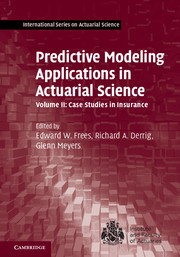
-
Select format
-
- Publisher:
- Cambridge University Press
- Publication date:
- 05 August 2016
- 27 July 2016
- ISBN:
- 9781139342681
- 9781107029880
- Dimensions:
- (247 x 174 mm)
- Weight & Pages:
- 0.73kg, 330 Pages
- Dimensions:
- Weight & Pages:
You may already have access via personal or institutional login
Book description
Predictive modeling uses data to forecast future events. It exploits relationships between explanatory variables and the predicted variables from past occurrences to predict future outcomes. Forecasting financial events is a core skill that actuaries routinely apply in insurance and other risk-management applications. Predictive Modeling Applications in Actuarial Science emphasizes life-long learning by developing tools in an insurance context, providing the relevant actuarial applications, and introducing advanced statistical techniques that can be used to gain a competitive advantage in situations with complex data. Volume 2 examines applications of predictive modeling. Where Volume 1 developed the foundations of predictive modeling, Volume 2 explores practical uses for techniques, focusing on property and casualty insurance. Readers are exposed to a variety of techniques in concrete, real-life contexts that demonstrate their value and the overall value of predictive modeling, for seasoned practicing analysts as well as those just starting out.
Awards
Winner, 2018 Kulp-Wright Book Award, American Risk and Insurance Association
Reviews
Praise for Volume 1:‘With contributions coming from a wide variety of researchers, professors, and actuaries - including several CAS Fellows - it's clear that this book will be valuable for any actuary whose main concern is using predictive modeling in his or her own work.'
David Zornek Source: Actuarial Review
Contents
Metrics
Altmetric attention score
Full text views
Full text views help Loading metrics...
Loading metrics...
* Views captured on Cambridge Core between #date#. This data will be updated every 24 hours.
Usage data cannot currently be displayed.
Accessibility standard: Unknown
Why this information is here
This section outlines the accessibility features of this content - including support for screen readers, full keyboard navigation and high-contrast display options. This may not be relevant for you.
Accessibility Information
Accessibility compliance for the PDF of this book is currently unknown and may be updated in the future.


